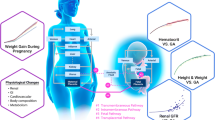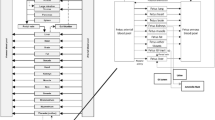Abstract
There are numerous studies which examine the disposition of theophylline from a traditional point of view. Information about the behaviour of drugs, including theophylline, is, however, very scarce when investigating the kinetics by means of a physiological flow model. This study is concerned with the development of a predictive analytical model for the pharmacokinetics of theophylline in nonpregnant and pregnant rats. This model postulates that specific organ or tissue masses may be simulated by compartments whose elements have physiological properties, e.g., tissue volumes, blood flow, and metabolic activity. A model has been developed that has blood, brain, hepatic, muscular, pulmonary, renal, and fetal tissues. With few exceptions, the agreement was good between predicted and calculated tissue data in the pregnant and nonpregnant rats. Finally, model simulations were performed to investigate the impact of different pulmonary extraction ratios on the concentration-time profile of theophylline in a “hypothetical” human patient.
Similar content being viewed by others
References
T. W. Rall. InThe Pharmacological Basis of Therapeutics, 6th ed. Goodmann and Gilman (eds.). Macmillan, New York, 1980, pp. 592–607.
C. W. Zwillich, F. D. Sutton, T. A. Neff, W. M. Conn, R. A. Matthay, and M. M. Weinberger. Theophylline induced seizures in adults.Ann. Intern. Med. 82:784–785 (1975).
J. Wagner.Fundamentals of Clinical Pharmacokinetics, 2nd ed. Drug Intelligence, Ill., 1975, pp. 92–96.
E. Labovitz and S. Spector. Placental Theophylline transfer in pregnant asthmatics.JAMA 247:786–788 (1982).
M. Bonati, R. Latini, G. Marra, B. M. Assael, and R. Parini. Theophylline distribution in the premature neonate.Dev. Phamacol. Ther. 3:65–73 (1981).
J. V. Wait and F. Clarke III.DARE-P, A Portable Digital Simulation System. University of Arizona, Tucson, 1974.
M. J. Arnaud, I. Bracco, and C. Welsch. Metabolism and distribution of labeled theophylline in the pregnant rat. Impairment of theophylline metabolism by pregnancy and absence of a blood-brain barrier in the fetus.Pediat. Res. 16:167–171 (1982).
G. Lam, M.-L. Chen, and W. L. Chiou. Determination of tissue to blood partition coefficients in physiologically based pharmacokinetic studies.J. Pharm. Sci. 71:454–456 (1982).
E. D. Adolph. Quantitative relations in the physiological constitutions of mammals.Science 109:579–585 (1949).
G. S. Dawes.Fetal and Neonatal Physiology, Year Book Medical, Chicago, 1968.
M. A. Heymann. Interrelations of fetal circulations and the placental transfer of drugs.Fed. Proc. 31:44–47 (1972).
M. Rowland and T. Tozer.Clinical Pharmacokinetics: Concepts and Applications. Lea & Febiger, London, 1980.
C. Bory, P. Baltassat, M. Porthault, M. Bethenod, A. Frederich, and J. V. Aranda. Metabolism of theophylline to caffeine in premature newborn infants.J. Pediat. 94:888 (1979).
A. L. Neese and L. F. Soyka. Toxicity and tissue distribution of aminophylline in neonatal and adult mice and rats.Pediat. Res. 11:783–789 (1977).
S. E. F. O'Donoghue. Distribution of pethidine and chloropromazine in maternal, fetal and neonatal biological fluids.Nature (Lond.) 229:124–125 (1971).
J. Gabrielsson and I. Paalzow. A physiological pharmacokinetic model for morphine disposition in the pregnant rat.J. Pharmacokin. Biopharm. 11:147–163 (1983).
J. L. Brazier, B. Ribon, M. Desage, and B. Salle. Placental transfer and fetal metabolism of theophylline study by use of stable isotopes and gas chromatographic mass spectrometric analysis.Recent Dev. Mass Spectrom. Biochem. Med. Environ. Res. 7:27–34 (1981).
J. V. Aranda, D. S. Sitar, and W. D. Parsons. Pharmacokinetic aspects of theophylline in premature newborns.N. Eng. J. Med. 295:413–416 (1976).
G. F. Cole and D. P. Davies. Theophylline poisoning.Br. Med. J. 52:280 (1980).
G. Levy. Pharmacokinetics of fetal and neonatal exposure to drugs.Obstet. Gynecol. 58, 9S-16S (1981).
P. O. Edlund. Personal communication.
G. Levy. Pharmacokinetic control of theophylline therapy. InClinical Pharmacokinetics: A Symposium. Am. Pharm. Assoc., Acad. Pharm. Sci., Washington, D.C., 1974, pp. 103–110.
T. N. Tozer. Concepts basic to pharmacokinetics.Pharm. Ther. 12:109–131 (1981).
Author information
Authors and Affiliations
Additional information
This study was supported by grants from the Swedish Council for Planning and Coordination of Research [(FRN)82/2090].
Rights and permissions
About this article
Cite this article
Gabrielsson, J.L., Paalzow, L.K. & Nordström, L. A physiologically based pharmacokinetic model for theophylline disposition in the pregnant and nonpregnant rat. Journal of Pharmacokinetics and Biopharmaceutics 12, 149–165 (1984). https://doi.org/10.1007/BF01059275
Received:
Revised:
Published:
Issue Date:
DOI: https://doi.org/10.1007/BF01059275




